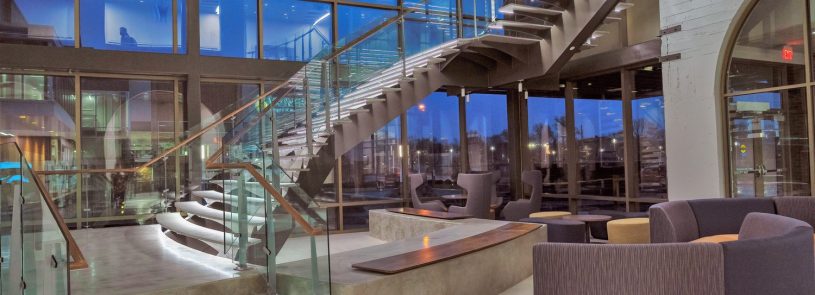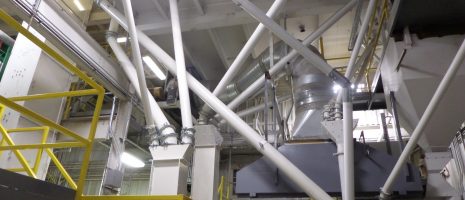Code compliance and early collaboration are critical for a monumental stair

By John Paul Goedken and Danielle DeBoer
Monumental stairs are often THE feature of a lobby. They are typically several times more expensive than a traditional stair, but what they add to the overall feel of a project can be priceless. The American Institute of Steel Construction (AISC) issued updated guidelines for the design of monumental stairs in 2016. Due to code adoptions throughout the country, the impact of these guidelines is just beginning to be understood throughout the design and construction industry.
Structural engineers typically design monumental stairs for vibration first, and then the strength of the stair is checked. These stairs are not connected into a larger floor system, and therefore do not have the weight or damping (vibration reduction) of typical floor beams. Because of these factors, vibration plays a crucial part in their design.
The updated AISC Steel Design Guide 11 provides current state-of-the-profession guidelines for vibration in many situations: natural frequency of floor systems (or the amount of time it takes to go through a complete range of motion), design for walking excitation in floors and stairs, rhythmic excitation, design for sensitive equipment, and guidance for finite element models. For monumental stairs, there are three checks prescribed by AISC:
- Vertical natural frequency of the stair must be greater than 5Hz
- Lateral natural frequency of the stair must be greater than 2.5Hz
- The vertical acceleration of the stair due to a descending individual or group is less than prescribed limits
The first two checks are basic functions of the stair geometry (rise, run, plan layout, support), the weight of the stair, and the stiffness of the stair. These need to be worked out by the architect and structural engineer early in the conceptualizing of the stair. If these general items can’t be agreed upon and result in a stair that does not meet the first two criteria, there is no point moving on to the more intricate design of acceleration.
The third check, for vertical acceleration limits, is defined from the point of view of a single person standing on the stair and “feeling” the vibration. The sensitivity a person has toward vibration varies widely due to many factors: lighting in the space, noise, activity, or simply the mood of the person. It can vary from person to person, and from day to day. AISC has tried to codify this as best as possible. There are three different sources of vibration/acceleration that are evaluated from this standing individual’s point of view:
- Another individual descending at a normal speed
- A rapidly descending individual
- A rapidly descending group
AISC has different parameters for each of these criteria. They all need to be evaluated for the stair.
Besides the code-given factors for the criteria, the damping of the stair also comes into play. This value is often fairly minimal for any stair, as there are no floor-to-floor partitions limiting the movement of the stair. One factor that can play a large part in the damping of the stair are the railings. Are they glass, metal mesh, or minimalist tubes? Are they connected into each tread, or only at 4 feet on center? Each configuration can affect the overall damping considerably. Since the “design” of the railing is typically coming from the architect, the structural engineer is simply reacting to what he or she is given.
Often, most of the stair is already designed by the architect for aesthetics, so the structural engineer’s job is simply to size the stringer. Larger stringers give more stiffness and will help with all three AISC checks. However, larger stringer sizes may not be desirable based on aesthetics and can make an otherwise elegant stair look clunky.
The best approach is to have the architect and structural engineer work as a team and discuss early on what are the important design features of the stair. Often, something simple — like an added support brace or a slight change in the railing design — will allow the stair design to still meet the architect’s vision while also meeting the AISC vibration criteria.













